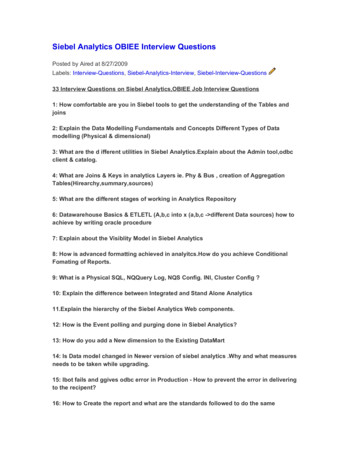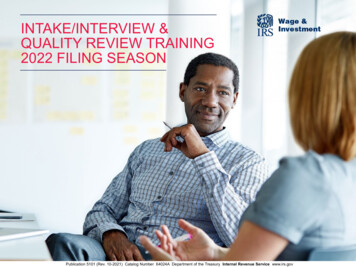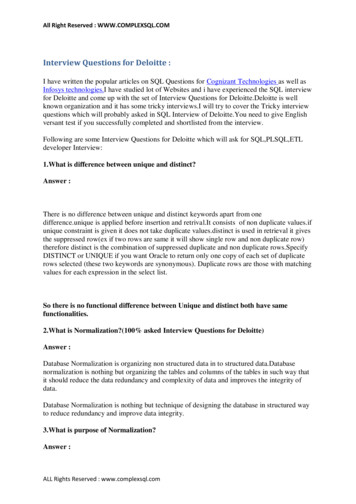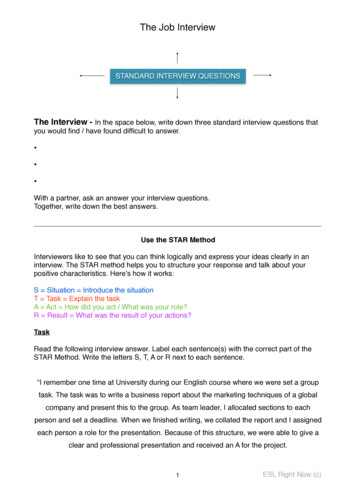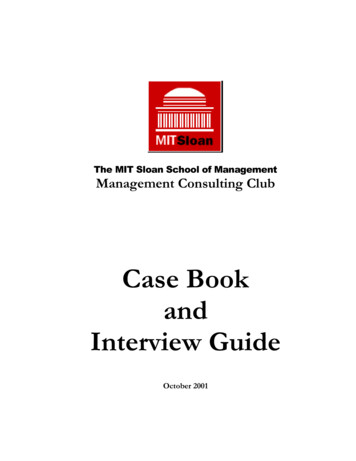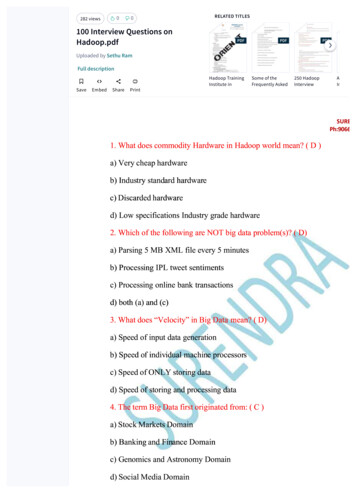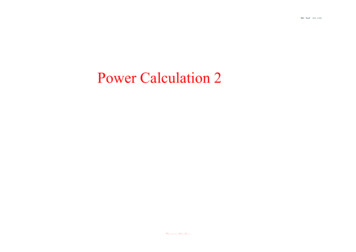
Transcription
Intake/Interview & Quality ReviewTraining2021 Filing SeasonPublication 5101 (Rev. 10-2020) Catalog Number 64024A Department of the Treasury Internal Revenue Service www.irs.gov1
The Objectives of this TrainingAt the end of this lesson you will be able to describe: The purpose of following a consistent Intake/Interview andQuality Review process. The different sections of Form 13614-C, Intake/Interview andQuality Review Sheet. The basic steps of a complete Intake Process. The basic steps of a complete Interview Process. The basic steps of a complete Quality Review Process.2
IntroductionTaxpayers using services offered through the VolunteerIncome Tax Assistance (VITA) and Tax Counseling for theElderly (TCE) Programs should be confident they receivequality service. This includes having an accurate tax returnprepared.A basic component of preparing an accurate return beginswith explaining the tax preparation process, completing allquestions on F 13614-C, listening to the taxpayer, andasking the right questions.Form 13614-C, Intake/Interview & Quality Review Sheet, isa tool designed to help ensure taxpayers are given theopportunity to provide all needed information before theirtax return is prepared. When used properly, this formeffectively contributes to accurate tax return preparation.3
The Purpose of this TrainingThe Internal Revenue Service (IRS) continues to emphasize the positivecorrelation between the proper use of the Intake/Interview and QualityReview Process and the preparation of an accurate tax return.IRS oversight reviews indicate consistent use of complete intake, interview,and quality review processes results in more accurate returns. Whenproperly used, the accuracy of VITA/TCE returns has increased.Per Quality Site Requirement #2, it is mandatory that Form 13614-C iscompleted for each tax return prepared. Volunteers who refuse to preparereturns without following the Intake/Interview process are in violation of theVolunteer Standards of Conduct.Our data shows that, in most cases, Form 13614-C is available at all sitesand taxpayers are completing the form. However, there are still challengeswith certified volunteer preparers not using this tool during the interviewand quality review processes.This training is designed to encourage all volunteers to follow a thoroughand consistent Intake/interview and Quality Review Process.4
.Materials Form 13614-C, Intake/Interview & Quality Review Sheet Form 14446 – Virtual VITA/TCE Taxpayer Consent Publication 4012, Volunteer Resource Guide Form 13614-C Job Aid in Publication 4012 Publication 17, Your Federal Income Tax Publication 5299, Quality Review Refresher Publication 5310, Tax Return Quality Review Job Aid Publication 5353, Fact Sheet for Partners andEmployees – Intake/Interview & Quality Review Policy5
MaterialsForm 13614-C Job Aid for Volunteers is located inPublication 4012, Volunteer Resource Guide.6
The Intake Process:Completing Form 13614-CMethods for completing Form 13614-C may vary from site tosite. In most cases, the taxpayer completes pages 1 through 3of the Form 13614-C before meeting with a tax preparer. Thepreparer then discusses all of the provided taxpayer information.Some sites prefer that volunteer tax preparers complete theintake form with the taxpayer while conducting an interview.At all sites, volunteers will complete the form with the taxpayer ifassistance is required. No matter what method used, allquestions on Form 13614-C must be answered.All taxpayers at Virtual VITA sites also need to complete Form14446 Virtual VITA/TCE Taxpayer Consent to give consent forthe site to prepare the return using the method(s) outlined in theform. Both spouses need to sign this form if married filing jointly.Note: Form 13614-C is printed in English and Spanish. It alsocan be downloaded from IRS.gov in the following languages:Chinese, Chinese Traditional, Creole, Korean, Polish, Tagalog,Portuguese, Russian and Vietnamese.7
The Intake Process:Verifying IdentityIdentity Theft continues to be a nationwide problem.The interview should begin by requiring a photo ID to verifythe identity of the taxpayer and spouse on the tax return.Exceptions for requiring a photo ID should only be madeunder extreme circumstances and for taxpayers known to thesite after being approved by the site coordinator.For more information, please refer to Publication 4299,Privacy, Confidentiality and Civil Rights - A Public Trust.8
The Intake Process:Return and Volunteer CertificationLevelsThe site must have a process to ensure the return is withinscope of the VITA/TCE Programs and to identify thecertification level needed for the tax return. The site must alsohave a process to ensure volunteers have the certificationneeded for the returns they prepare.Form 13614-C includes certification levels as shown: (B) for Basic (A) for Advanced (M) for Military9
The Interview ProcessDo not begin entering taxpayer information into the softwareuntil you have completed a thorough interview with the taxpayerbecause you may find at any point in the interview process that: The tax return is above your certification level The tax return is outside the scope of the VITA/TCEPrograms The taxpayer does not have all needed information ordocumentationDiscovering these things before starting a return will saveyour time, the taxpayer’s time, and will avoid frustration.10
The Interview Process:Clarifying QuestionsYou should update or correct the intake sheet with anychanges identified during the interview with the taxpayer.This review and discussion is a great opportunity to engagethe taxpayer in a conversation. Make sure the taxpayerunderstands all of the questions and that you understand all oftheir answers.Clarifying information while reviewing Form 13614-C duringthe Interview is a very effective way to gather all neededinformation.For example:"You marked that no one else lived in your home. Is thatcorrect?""Is your pension your only source of income?"11
The Interview Process:Conflicting InformationBe alert for conflicting information. Sometimes an entry on onepart will raise a question on another part of Form 13614-C.For example:"I see that you and your husband both worked, yet you did notindicate you paid any childcare expenses for your 3-year-oldson.““I see that you are over the age of 65, but you did not indicatethat you received Social Security benefits.”“I see that you answered “No” to the question ‘Can anyoneclaim you on their tax return?’ But since you're a student livingwith you parents, I'm wondering if they can claim you?”12
The Interview Process: Form 13614-CPart I - Your Personal InformationVerify that the information in Part I is correct and complete.Ensure that the names match the social security documents.Note: If the taxpayer indicates that they are not a U.S. citizen,use the flow chart in Publication 4012 to verify that you arecertified to prepare their return.13
The Interview Process: Form 13614-CPart I - Your Personal InformationInformation in Part I impacts many tax law determinations.For example, when a taxpayer is a “full-time student” it mayimpact multiple tax law issues such as: Child and Dependent Care Credit Retirement Savings Contributions Credit Various Education Credits Whether the taxpayer can be claimed as a dependentNote: Use Publication 17 Your Federal Income Tax to verifythat the taxpayer meets the “full-time student” requirement.14
The Interview Process: Form 13614-CPart 1The fact that the taxpayer is “totally and permanently disabled” or“legally blind” may affect multiple tax law issues such as: Personal exemption Pension taxability Whether the taxpayer can be claimed as a dependentNote: Verify the taxpayer does meet the requirements for “totallyand permanently disabled” or “legally blind” as defined inPublication 17.15
The Interview Process: Form 13614-CPart II -Marital Status and HouseholdInformationInformation in this section will help you make determinationsabout: Filing Status Dependency Exemptions Various credits and deductionsNote: Many taxpayers think they should only list "dependents." Besure to discuss this section with the taxpayer.16
The Interview Process: Form 13614-CPage 2 – OverviewA critical part of the interview process is to make sure all thequestions on page 2 of Form 13614-C are complete. Thetaxpayer may have left a question unanswered or marked thequestion "Unsure" because they did not understand it.These questions should be discussed with the taxpayer todetermine the correct “Yes" or “No" response and recorded onthe form prior to beginning the tax return preparation.Note: Make notes on Form 13614-C during your interview anduse the Additional Comments section on page 3 to ensure theQuality Reviewer has all required information to determine thereturn is accurate.17
The Interview Process: Form 13614-CPage 2 - Part III IncomeTaxpayers are asked about income received and should checkthe appropriate line item “Yes”, “No” or “Unsure”.Each income item includes the type of forms used to report theincome (in parenthesis). As you discuss each of the questions,ensure that the answers agree with the documents provided bythe taxpayer. You should change the original answer on Form13614-C with any updated information as needed.Update Form 13614-C with any changes from the taxpayer’soriginal answers.18
The Interview Process: Form 13614-CPart III - IncomeYou must conduct an extensive interview to ensure thattaxpayers who are self-employed are reporting all incomeincluding cash payments received for work performed.Note: You should always verify the taxpayer has provided allthe necessary source documents and information.19
The Interview Process: Form 13614-CPage 2 - Part III IncomeIt is necessary to ask clarifying questions, even if all thequestions on Form 13614-C have been answered.For example, if the taxpayer checks “Yes” to the question“Distribution from Pensions, Annuities and/or IRA?”, and theyhave already given you a Form 1099-R from an IRAdistribution.You should then ask, “Is this your only distribution?”At that point, you may find the taxpayer left a Form 1099-R athome and will have to return with it before the return can beprepared.20
The Interview Process: Form 13614-CPart IV - ExpensesQuestions in this section help alert you to expenses paid bythe taxpayer that may affect their return.The fact that a taxpayer had an expense is not the onlyconsideration for a tax deduction or credit.You will need to use your reference materials to determineeligibility for deductions and credits and take intoconsideration the most advantageous position for thetaxpayer.21
The Interview Process: Form 13614-CPart V - Life EventsThe Life Events section asks numerous questions that relateto the calculation of tax and the processing of the return.Note: Publication 17 and Publication 4012 contain additionalinformation that needs to be collected to make a correctdetermination.22
The Interview Process: Form 13614-CPage 3 - Additional InformationThe taxpayer will indicate how they want to receive their refund aswell as other information which may be needed to complete thereturn.Demographic information in this section may be collected andentered into the tax software. Ask your site leader about how torecord the demographic information.23
The Interview Process: Page 4Form 15080This form is used by sites to obtain the taxpayer's consent tomake their tax return information available to any VITA/TCE sitethat the taxpayer selects to have their tax return prepared at inthe next filing season. The taxpayer has the option to decline thisconsent. Your site leader will instruct you on the site’sprocedures on how this form will be completed by the taxpayer.24
The Interview Process: Due DiligenceIRS-certified volunteer preparers are required to exercise duediligence. This means, as a volunteer, you are required to do yourpart when preparing or quality reviewing a tax return to ensure theinformation on the return is correct and complete.Generally, as an IRS tax law-certified volunteer, you can rely in goodfaith on information from a taxpayer without requiring documentationas verification.However, part of due diligence requires asking a taxpayer to clarifyinformation that may appear to be inconsistent or incomplete. Whenreviewing information for its accuracy, you need to ask yourself if theinformation is unusual or questionable.For example: You do not need to see proof of a taxpayer’s cashcontribution to a charity if you feel comfortable that this information isnot unusual or questionable.Remember, if you are not comfortable with the information providedby a taxpayer, you are not obligated to prepare the tax return.25
Preparing the Tax ReturnAfter you complete the intake and interview process, prepare thereturn in the tax preparation software.Consult references and tools to determine filing status,exemptions, income, adjustments, deductions, credits, orpayments.Remember: Publication 4012 contains tax law information, andguidance on using tools embedded in the IRS-provided software.Other references include Publication 17 and Volunteer Tax Alerts.Once the return is prepared, a Quality Reviewer will use theQuality Review Checklist located in Publication 4012 to completethe Quality Review.26
Quality Review ProcessIntroductionThe purpose of a Quality Review is to ensure that thetaxpayer's tax return is accurate based on the Intake/InterviewSheet, and the supporting documents provided by the taxpayerand the interview with the taxpayer.Sites will conduct a Quality Review of every return prepared.Having a second pair of eyes, focused on the Quality Review,offers the best opportunity to correct small errors before theycan cause big problems.The Quality Review takes place after the return is prepared, butbefore the taxpayer signs the return.27
Quality Review MethodThe quality review method that a site uses depends on the sitesize, the number of experienced volunteers available, and thecertification level of the volunteers at the site.There are two acceptable methods: Designated Review - This preferred quality review methodemploys a designated Quality Reviewer, a volunteer who issolely dedicated to reviewing returns prepared by the othervolunteers at the site. Peer Review - When a designated Quality Reviewer is notavailable, volunteers can review each other’s returns.Note: Self-Review, quality reviewing a return you prepared, isnot an acceptable quality review method.Publication 5299, Quality Review Refresher and Publication5310, Tax Return Quality Review Job Aid are available forvolunteers who will be performing the role of a Quality Reviewer.28
Quality Review ProcessThe Quality Review Process must include four critical actions: Engaging the taxpayer in the review process. Using the Quality Review Checklist in Publication 4012during every review. Comparing all information provided by the taxpayer on Form13614-C and supporting documents against the completedtax return entries. If necessary, using reference materials to verify that tax lawdeterminations are correct.29
Quality Review ChecklistAll items on the Quality Review Checklist must be addressedduring a quality Review. The Quality Review Checklist is locatedin Publication 4012.30
Course SummaryIn this course, you have learned that: SPEC has determined there is a direct correlation between theproper use of Form 13614-C and the preparation of an accuratetax return. Form 13614-C, Intake/Interview and Quality Review Sheet,must be used to complete and quality review all tax returns atVITA/TCE sites. An effective interview must be performed to verify taxinformation for each tax return. All quality reviews must be conducted by a designated or peerto-peer quality reviewer.31
Test QuestionsQuestion 1All IRS-certified volunteer preparers participating in theVITA/TCE programs must use Form 13614-C along with aneffective interview for every return prepared at the site.A. TrueB. False32
Test QuestionsQuestion 2What should the certified volunteer preparer do before starting thetax return?A. Make sure all questions on Form 13614-C are answered.B. Change “Unsure” answers to “Yes” or “No” based on aconversation with the taxpayer.C. Complete all applicable Certified Volunteer Preparer shadedarea questions on Form 13614-C.D. All of the above.33
Test QuestionsQuestion 3When reviewing Form 13614-C, you see the "Interest" question ismarked "Yes" and the taxpayer gives you a Form 1099-INT. Youshould ask the taxpayer if they had any other interest income.A. TrueB. False34
Test QuestionsQuestion 4VITA/TCE sites are required to conduct Quality Reviews:A. Of all the returns prepared by volunteers who have less thantwo years of experience preparing returns.B. Of every return prepared at the site.C. Only when there is a Quality Reviewer available.D. Of all returns prepared by volunteers with certification levelsbelow Advanced, Military, or International.35
Test QuestionsQuestion 5You do not need to see proof of cash donations made bytaxpayer if you feel that the information is not unusualor questionable.A. TrueB. False36
Test QuestionsQuestion 6In most cases a volunteer must review photo identification forevery taxpayer(s) to deter the possibility of identity theft.A. TrueB. False37
Test QuestionsQuestion 7When does the taxpayer sign the tax return?A. Before quality review and before being advised of theirresponsibility for the accuracy of the information on the return.B. Before quality review and after being advised of theirresponsibility for the accuracy of the information on the return.C. After quality review and before being advised of theirresponsibility for the accuracy of the information on the return.D. After quality review and after being advised of theirresponsibility for the accuracy of the information on the return.38
Test QuestionsQuestion 8The site is busy with many taxpayers waiting for assistance. Allvolunteers are busy preparing tax returns. Can you quality reviewthe return you just prepared instead of waiting for someone else toquality review the return?A. Yes, if it is a returning taxpayer.B. Yes, with approval of the site coordinator.C. No, self review is never an acceptable quality review method.D. No, unless you are certified at the Advanced level.39
Test QuestionsQuestion 9Which of the following is true?A. Quality review can be conducted by a volunteer preparercertified at Basic when the tax return required an Advancedcertification to prepare.B. Quality review is conducted after the taxpayer signs the taxreturn.C. Quality review is an effective tool for preparing an accurate taxreturn.D. Taxpayers do not need to be involved in the quality reviewprocess.40
Test QuestionsQuestion 10As part of the intake process, each site must:A. Have a process to ensure a return is within the scope of theVITA/TCE Programs.B. Identify the certification level needed to prepare a return.C. Have a process to ensure volunteers have the certificationneeded for the returns they prepare.D. All of the above.41
Retest QuestionsRetest Question 1When should an IRS-certified volunteer preparer participatingin the VITA/TCE programs perform a complete interview of ataxpayer?A.B.C.D.Only when the taxpayer has questions.Only if the taxpayer has never visited your site.Only when the site is not busy.For every return prepared at the site.42
Retest QuestionsRetest Question 2The certified volunteer preparer should verify the return iswithin their certification level as part of the Intake/Interviewprocess.A. TrueB. False43
Retest QuestionsRetest Question 3When reviewing Form 13614-C, you see the "Interest" question ismarked "Yes" and the taxpayer gives you a Form 1099-INT. Whatshould you do next?A. Input Form 1099-INT into tax software.B. Go to the next question on Form 13614-C.C. Ask the taxpayer if they had any other interest income.44
Retest QuestionsRetest Question 4VITA/TCE sites are required to conduct quality reviews of everyreturn prepared at the site.A. TrueB. False45
Retest QuestionsRetest Question 5A taxpayer tells you that they donated 50 to their church but theydid not bring proof of the donation. This information along with allother information gathered during your interview does not seemunusual or questionable.As a tax preparer, you should:A. Send the taxpayer home to get proof of their donation.B. Prepare the return giving credit for the donation without seeingproof.C. Prepare their return without giving them credit for the donation.46
Retest QuestionsRetest Question 6What information should a volunteer review to deter the possibilityof identity theft?A. Form W-2.B. Photo identification.C. Last year’s tax return.D. Medicaid card.47
Retest QuestionsRetest Question 7The taxpayer signs the tax return after quality review and afterbeing advised of their responsibility for the accuracy of theinformation on the return.A. TrueB. False48
Retest QuestionsRetest Question 8You can quality review a tax return you just prepared instead ofwaiting for someone else to quality review the return.A. TrueB. False.49
Retest QuestionsRetest Question 9Which of the following four critical processes for quality review isnot correct:A. Engaging the taxpayer in the review process.B. Using Google as a main reference for tax law determinations.C. Using the Quality Review Checklist located in Publication 4012as a guide while conducting the quality review.D. Comparing source documents provided by the taxpayer.50
Retest QuestionsRetest Question 10Completing a thorough interview before entering taxpayerinformation into the software helps avoid which of the followingpotential problems?A. The volunteer may not have the required certifications toprepare the return.B. The return may be out-of-scope.C. The taxpayer may not have all the information needed toprepare the return.D. All of the above.51
Certificate Goes Here
correlation between the proper use of the Intake/Interview and Quality Review Process and the preparation of an accurate tax return. IRS oversight reviews indicate consistent use of complete intake, interview, and quality review processes results in more accurate returns. When prope




